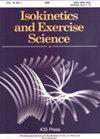比较健康志愿者在有无等长内收的 Y 形上举运动中的上下斜方肌肌电活动
IF 0.7
4区 医学
Q4 ENGINEERING, BIOMEDICAL
引用次数: 0
摘要
背景:下斜方肌(LT)在保持肩胛骨稳定性方面发挥着重要作用。充分激活肩胛下肌可降低肩袖撕裂和肩撞击综合征的风险。Y 形上举运动被推荐用于有效激活 LT。然而,在普遍的 Y 形上举运动中,斜方肌上部(UT)也会被共同激活。目的:本研究旨在比较在使用 Thera-Band 进行 Y 形上举锻炼和不进行等长内收(IAD)时,UT、LT 和前锯肌(SA)的活动情况。方法:21 名健康男性自愿参与研究。研究人员要求受试者使用 Thera-Band 进行有 IAD 和无 IAD 的 Y 形上举运动。研究人员使用表面肌电图测量了有无 IAD 的 Y 形上举运动中 UT、LT 和 SA 的肌肉活动。采用配对 t 检验分析 UT、LT 和 SA 肌肉活动以及 LT/UT 和 LT/SA 活动比率的显著性。显著性水平设定为α= 0.05。结果:与不含 IAD 的 Y 形抬高运动相比,在含 IAD 的 Y 形抬高运动中,UT 和 SA 的肌肉活动减少(p= 0.001 和 p=0.003),而 LT 的肌肉活动增加(p= 0.038)。此外,在使用 IAD 进行 Y 型抬高运动时,LT/UT 和 LT/SA 的活动比率更大(分别为 p= 0.001 和 p=0.001)。结论:建议使用 Thera-Band 进行带 IAD 的 Y 形抬高运动,这是一种有效的运动,可选择性地激活 LT 并提高 LT/UT 和 LT/SA 的活动比率。本文章由计算机程序翻译,如有差异,请以英文原文为准。
Comparison of upper and lower trapezius electromyographic activity during Y-raise exercise with and without isometric adduction in healthy volunteers
BACKGROUND: Lower trapezius (LT) plays an important role in maintaining the stability of the scapula. Sufficient activation of LT can reduce the risk of rotator cuff tear and shoulder impingement syndrome. The Y-raise exercise has been recommended for effective LT activation. However, the upper trapezius (UT) can be co-activated during universal Y-raise exercise. OBJECTIVE: This study aimed to compare the activity of the UT, LT, and serratus anterior (SA) during Y-raise exercise with and without isometric adduction (IAD) using Thera-Band. METHODS: 21 healthy males voluntarily participated in the study. The participants were asked to perform Y-raise exercise with and without IAD using Thera-Band. Surface electromyography was used to measure the muscle activity of UT, LT, and SA during Y-raise exercise with and without IAD. Paired t-test was used to analyze the significance of the muscle activity of UT, LT, and SA as well as the activity ratio of LT/UT and LT/SA. The significance level was set at α= 0.05. RESULTS: Compared with Y-raise exercise without IAD, the muscle activity of UT and SA decreased (p= 0.001 and p= 0.003, respectively), whereas that of LT increased (p= 0.038) during Y-raise exercise with IAD. Additionally, the activity ratio of LT/UT and LT/SA was greater during Y-raise exercise with IAD (p= 0.001 and p= 0.001, respectively). CONCLUSION: Y-raise exercise with IAD using Thera-Band is recommended as an efficient exercise to selectively activate the LT and increase the activity ratio of LT/UT and LT/SA.
求助全文
通过发布文献求助,成功后即可免费获取论文全文。
去求助
来源期刊

Isokinetics and Exercise Science
医学-工程:生物医学
CiteScore
1.20
自引率
14.30%
发文量
37
审稿时长
>12 weeks
期刊介绍:
Isokinetics and Exercise Science (IES) is an international journal devoted to the study of theoretical and applied aspects of human muscle performance. Since isokinetic dynamometry constitutes the major tool in this area, the journal takes a particular interest in exploring the considerable potential of this technology.
IES publishes studies associated with the methodology of muscle performance especially with respect to the issues of reproducibility and validity of testing, description of normal and pathological mechanical parameters which are derivable from muscle testing, applications in basic research topics such as motor learning paradigms and electromyography. The journal also publishes studies on applications in clinical settings and technical aspects of the various measurement systems employed in human muscle performance research.
The journal welcomes submissions in the form of research papers, reviews, case studies and technical reports from professionals in the fields of sports medicine, orthopaedic and neurological rehabilitation and exercise physiology.
 求助内容:
求助内容: 应助结果提醒方式:
应助结果提醒方式:


